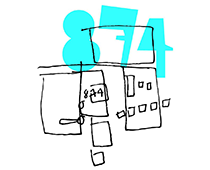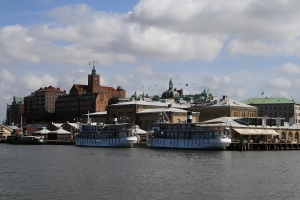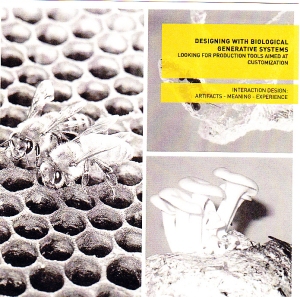10th European Academy of Design Conference EAD,
April 17-19, 2013 in Gothenburg, Sweden
In April 2013 the 10th EAD conference, was held in the beautiful city of Gothenburg, in southern Sweden. The venue for the event was the local faculty: School of Design and Crafts (HDK) and the Röhsska Museum.
This year’s conference was dedicated to the topic ‘Crafting the future’. “Designing is about crafting, making, visualizing, and imagining the future, regardless of whether we are involved with products, services, fashion, interactions, or other areas of practice.” (1) The conference`s subject asks designers to relocate their focus of practice and research to picture and strive for a change towards a better and more sustainable future. This shift also changes the role of the designer opening up a wide range of opportunities for designers of any discipline to approach their responsibilities regarding sustainability.
The conference hosted about 200 participants and was opened on Tuesday evening, the 16th of April, with an inspiring talk by Kate Fletcher, a researcher at London College of Fashion. She discussed the necessity of alternative fashion systems to challenge consumerism influence on fashion. Fashion has to recognize the value of different activities, broader than currently applied. She illustrated examples on ‘craft of use’ through her ‘Local Wisdom’ project. (2)
During the next two and a half days there were 10 tracks, encouraging different design disciplines to contribute, among them also an open track, workshops and poster sessions. I mostly attended presentations about ‘Fashion Design For Sustainability’ and ‘MAKING TOGETHER – Open, Connected, Collaborative’ where I also presented a paper, co-authored by Kirsi Niinimäki (3).
Within this track, there were a great number of papers on the subject of social innovation, open design, co-design, co-creation and participatory design in different contexts. The presentations clearly reflected that design is challenged with new ways of production and manufacture, e.g. peer production, fablabs, crowd sourcing, collaborative business models and many more. Among the most common topics were projects which try to engage local communities for creating new collaborative business models, or starting interventions within their neighborhood. Design has the power to reposition and change meaning of tools and technology by making it accessible and useable for the people, so they can connect, share and co-create.(4) This offers the designer the role of a facilitator, enabler and a design activist. However we need to question how to redefine the designers role and “What are the implications/benefits/impact of collaborative making for design? Can designers design collaborative networks?” (5)
I followed interesting discussions on a question which I was wondering for a while: How deeply should a designer be engaged in the managing- and facilitation role, to be able to leave the community someday, working with their own drive and motivation? How to design for a self-sustaining community project or in the best case a collaborative business strategy?
Surely this depends on the community, project and circumstances itself. However, it was interesting to see the variety of applications for design activism tools and methods, for example in the setting of a community. Within our discussion group, we could clearly identify using similar methods in very different contexts (e.g. individualized and co-made products, openness in participatory design and fashion activism). Based on the flexibility and creativity of the designer, tools can be extended, applied and redesigned according to the requirements.
Many projects focused on creating new small scale business and production models. For example how to use biological systems as tools to create individualized products (Raul Pinto, PhD student, ID+Research, University of Aveiro). For me the research was illustrated with great examples, which can be placed somewhere between product-design and art, the beauty of the unpredictable.
Another example was local crafting techniques which are able to replace abundant resources with waste materials, showing the power of craft and creativity within a community itself (Renata Leitoa). Examples drawn from Milan (Daniela Selloni) were representing active citizenship in design and service development with examples like http://cittadinicrativi.it/.
Other papers that caught my attention were elaborating upon the role of ‘openness’ in participatory research (Katrien Dreessen) and Open Source Software for qualitative and collaborative graphic design (Ginger Coons) http://libregraphicsmag.com/
For the last day of the conference, Otto von Busch did a great and enthusiastic key-note, exploring “Co-craft and The Capabilities of Industriousness”. He illustrated how crafting can enable the people with skills and capabilities for greater freedom, applying the “capabilities approach” of economist Amartya Sen. This would allow a shift from objects towards crafting as a tool to gain greater freedom. Based on this idea, craft can be seen as a tool to engage political and social justice.(6)
1) EAD – Crafting the Future, About, retrieved at: http://www.craftingthefuture.se/, 06.05.2013
2) EAD – Crafting the Future, Kate Fletcher, retrieved at: http://www.craftingthefuture.se/text/rohsska.html, 06.05.2013
3) Hirscher, A.L. and Niinimäki, K. 2013, ‘Fashion Activism through Participatory Design’, paper presented at the Conference Crafting the Future, Gothenburg, April 17.-19.2013
4) EAD – Crafting the Future, MAKING TOGHETHER, retrieved at: http://www.craftingthefuture.se/papers/calledpaper4.html, 06.05.2013
5) ibid.
6) EAD – Crafting the Future, Keynote Speakers, retrieved at: http://www.craftingthefuture.se/, 06.05.2013




